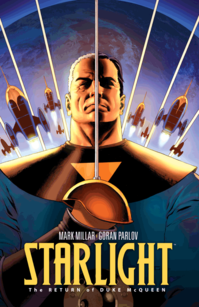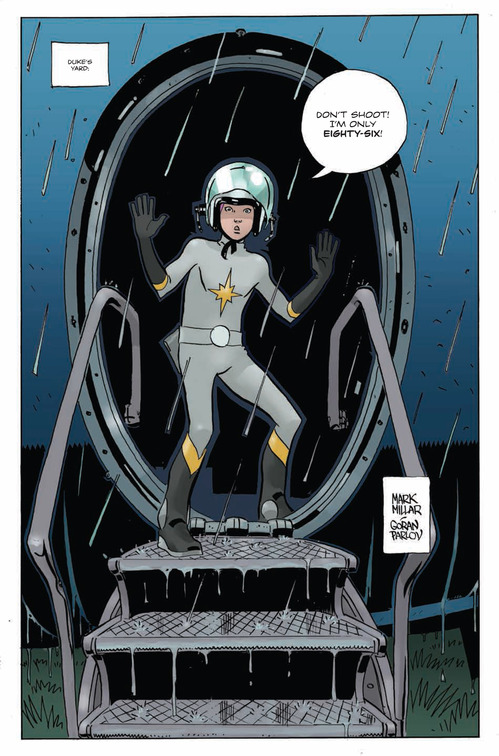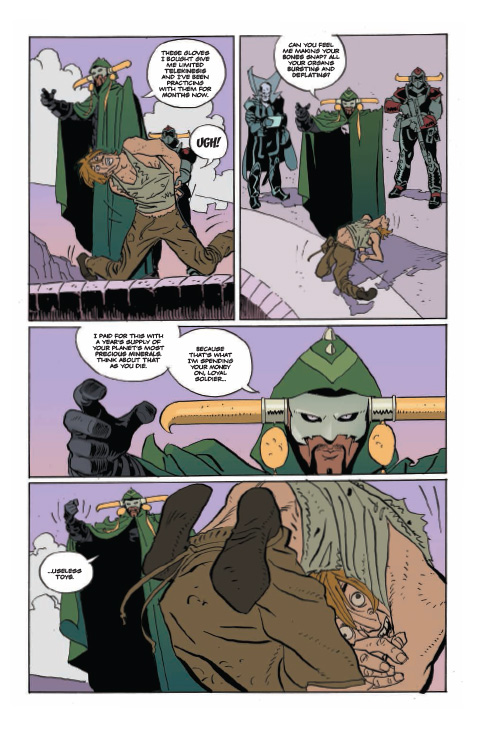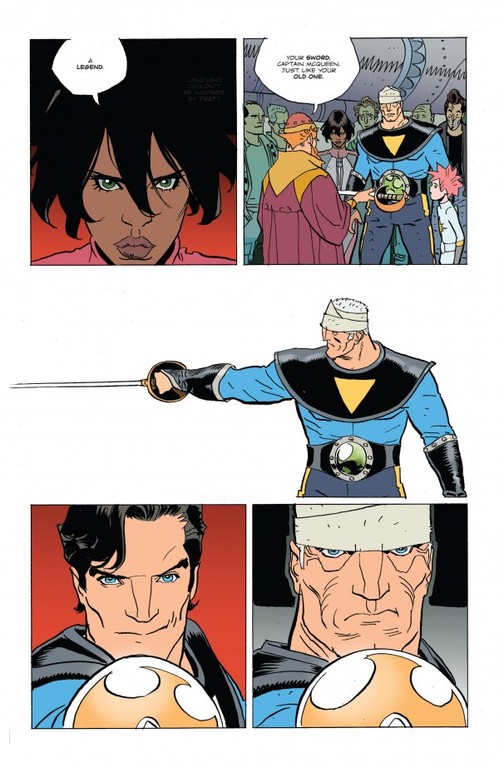Starlight: How Mark Millar Got Inclusive and Wrote the Best Comic of His Career
Comics Features Mark MillarMark Millar writes quintessentially cinematic comics, made to be made into movies. In tandem with extraordinary artists, the Scottish scribe crafts kinetic, self-contained stories featuring original characters in familiar environs. His protagonists are superheroes designed realistically, pragmatically — some even resemble specific actors. A filmic ethos runs through his work, and it’s why his runs on The Ultimates and Ultimate Fantastic Four inspired the movie iterations of The Avengers and director Josh Trank’s upcoming Fantastic Four, four of his creator-owned books have been adapted directly and six more have been optioned.
But for all the interest in his work, filmmakers run into a problem when attempting to adapt it. Numerous journalists, critics and fans have noted questionable racial and sexual imagery when parsing Millar’s oeuvre. These aspects are quite controversial, and, while they do garner Millar press, it’s largely negative. Consequently, every direct and indirect adaptation has been altered to avoid even the potential for this controversy.
Starlight, Millar’s recently-completed 6-issue Image series with art from Goran Parlov and covers from John Cassaday, was optioned before its first issue even hit the stands. Keeping in mind the way Hollywood uniformly adapts his work, the book stands out as a particularly conscious work and may mark a turning point in the writer’s career. The comic contains all the bombastic pacing and blockbuster set pieces that fans of his work will be familiar with, but it sheds the same problematic aspects that all successful adaptations of his work do, delineating it from Millar’s previous work.
The series concerns a man named Duke McQueen returning to Tantalus, the distant planet he saved forty years ago. Moebius, Flash Gordon and The Incredibles appear to be the narrative’s biggest influences, shining through in the action-adventure energy that permeates the series. Starlight embraces its Golden Age sci-fi roots and indulges in unapologetic camp, which gives the comic a patina of pure, mindless escapism. But even though it is a genuine pleasure to read, the book also marks the first time in over a decade that Millar seems interested in wrestling with anything arguably substantive. In his meditation on 21st century superheroics, The Ultimates, he examined how superheroes would impact a world at war with terror, and in Starlight he returns to those same ideas generated by events like the Iraq War. In this series, he reckons with the consequences of “spreading democracy” and imposing a given value system on an alien culture. Wading into this intellectual gray area, Millar paints his sci-fi analog with a visceral level of real-world complexity and nuance, and he doesn’t fall into the same trap of separating characters into the clearly-delineated binaries of good and evil that he normally does.
In his earlier works, Millar’s depictions of people of color are similarly simple. In Ultimate Comics: Avengers, Millar introduces a black Hulk — one who changes his name from “Leonard Williams” to “Tyrone Cash,” abandons his family and turns to crime the minute he’s given the opportunity. The black characters in Wanted mock protagonist Wesley Gibson’s whiteness, intimidating and attacking him for it; he’s proudly prejudice and his prejudices are never disproven. The titular hero in Kick-Ass relentlessly beats drug dealers and gang members, roles ascribed to people of color, though he and his father sexually fetishize the only exceptions. Conversely, the black characters in Starlight are more complex.
Within a couple issues, Millar introduces characters like Krish Moor, Tilda Starr and Lord Kingfisher. Nicknamed Space-Boy, Krish seeks out McQueen in the first pages of the second issue. Millar gives Krish an enormous amount of agency, and Krish is rarely just a pawn to further the story of other characters. Rage and vengeance motivate him, and his backstory is tragic. Krish learns and grows and experiences ups and downs. Sequences move around him, and he’s more than just a sidekick — he’s a fully-fledged leading character. And though he’s an alien, he’s drawn to resemble general Asian humans and, were he a few years younger, Big Hero 6’s Ryan Potter could be cast perfectly in a film adaptation.
But while Krish’s racial identity may be somewhat ambiguous, Tilda Starr and Kingfisher are clearly black characters. Unlike his previous books, these characters represent a spectrum of heroism and villainy, and Starlight doesn’t stereotype them.
Motivated by a perceived supremacy, Kingfisher rules his conquered territory with fear and violence. He refers to himself as a predator, and it’s as if that predation is innate, natural. His actions are harsh, but backed by pathos. Culture, history and experience guide his hands. And Kingfisher is usually implicitly cruel — in fact, white characters usually dole out the lion’s share of violence and white characters usually receive it.
Millar historically provides his women with similarly narrow roles. In Kick-Ass, for example, Millar dispatches with the mother of protagonist Dave Lizewski within the first few page; Dave’s crush, Katie, uses him to run errands and then sends him a photograph of her performing oral sex on her boyfriend when she learns of Dave’s desires. In Kick-Ass 2, supervillains attempt to exploit Katie’s relationship to Dave; they murder her father and rape her. The only women with any agency, Hit-Girl and Mother Russia, are the two most physically capable characters in the series, but their male co-stars mock them because of it.
Compared to the women in previous Millar comics, Starlight’s Tilda Starr compares favorably. Smart, experienced, strong and driven, she vows to never repeat the past mistakes that haunt her. That vow motivates her, and she leads her people with vigor and wisdom. Oftentimes, physical strength is substituted for complexity of character, but Tilda’s intelligence and cunning aren’t undermined by the fact that she can hold her own in a fight. And though Tilda is far from infallible, Millar doesn’t give her the short shrift; she’s instrumental in the machinations of the finale, and that import is recognized by other characters. With Tilda, Millar proves himself not only capable of writing interesting, nuanced roles for women, but for people of color as well.
However, strong representation isn’t necessarily an indicator of quality, and Starlight isn’t a perfect work. Moving along at a compressed pace, the series simply lacks the time or space to do anything but hint at its characters’ interiority. While Millar is able to expose enough facets to make them engaging in the moment, Starlight could’ve benefitted from more time to flesh out the characters even further. The same could be said about the comic’s world. But these are minor blemishes at best, and, in spite of them, the book manages to be one of Millar’s finest.
The writer consistently works with some of the best living cartoonists, but he rarely gets that superlative quality out of them. However, he gives Goran Parlov breathing room and allows the artist to create. Proving his inimitability, Parlov illustrates the series with aplomb: the way McQueen’s craggy, wrinkled skin sags and softens, Parlov relaxing and tightening the musculature with a single line. Everything from the retro-futuristic designs to the staccato, bombastic action sequences and the tactile, affecting viscera carries a consistent grandiosity.
And, for once, Millar doesn’t contrive a story around weightless action. He imbues McQueen with delectable pathos, and Parlov draws placid scenes of cigarette smoking and stargazing serenely — to the point of tangibility. Millar observes loss and nostalgia insightfully, maturely, delivering a script that matches Parlov’s level of craftsmanship. The series makes fantastic use of the serial format and chooses its chapter endings well, utilizing the cliffhanger exceptionally, though it could’ve benefitted from an additional issue or two.
The series does suffer other narrative deficiencies, too. For starters, the dramatic crux is that an alien people must rely on the intervention and guardianship of a saber-wielding white man to survive — an abstraction open to possibly controversial connotations. More concretely, however, Starlight world-builds primarily with asides and narrative implications, but it fails to sufficiently follow up on them. For example, a few characters fetishize Earth culture, which is surprising because Millar portrays Tantalus as an isolated planet. However, the story is engaging: Millar sets the tempo at a brisk pace that recalls Edgar Rice Burroughs; Goran Parlov lushly renders the world, composing it with a keen eye for action and facial expressions. Most significantly, though, the series lacks the usual representational pratfalls that castrate the readability of most Millar comics. By comparison, Starlight is thoughtful and considered, and it’s a genuinely rewarding experience.
Stronger representations usually correlate to more complex works — they represent a creator thinking more, being more conscious of his or her choices and considering them more — and the way Millar simultaneously sheds the more problematic aspects of his work and delivers his strongest work to date substantiates that correlation.





